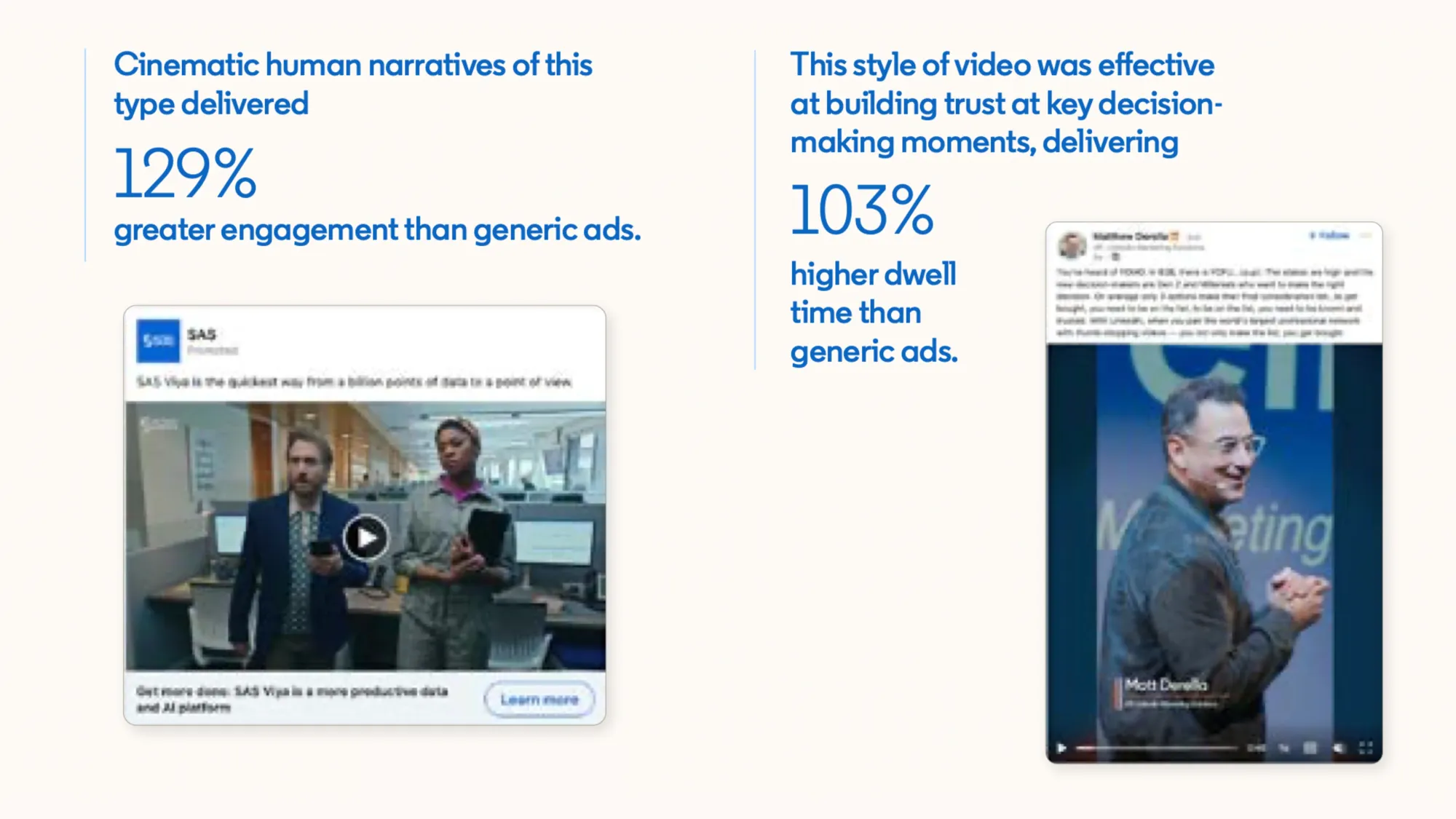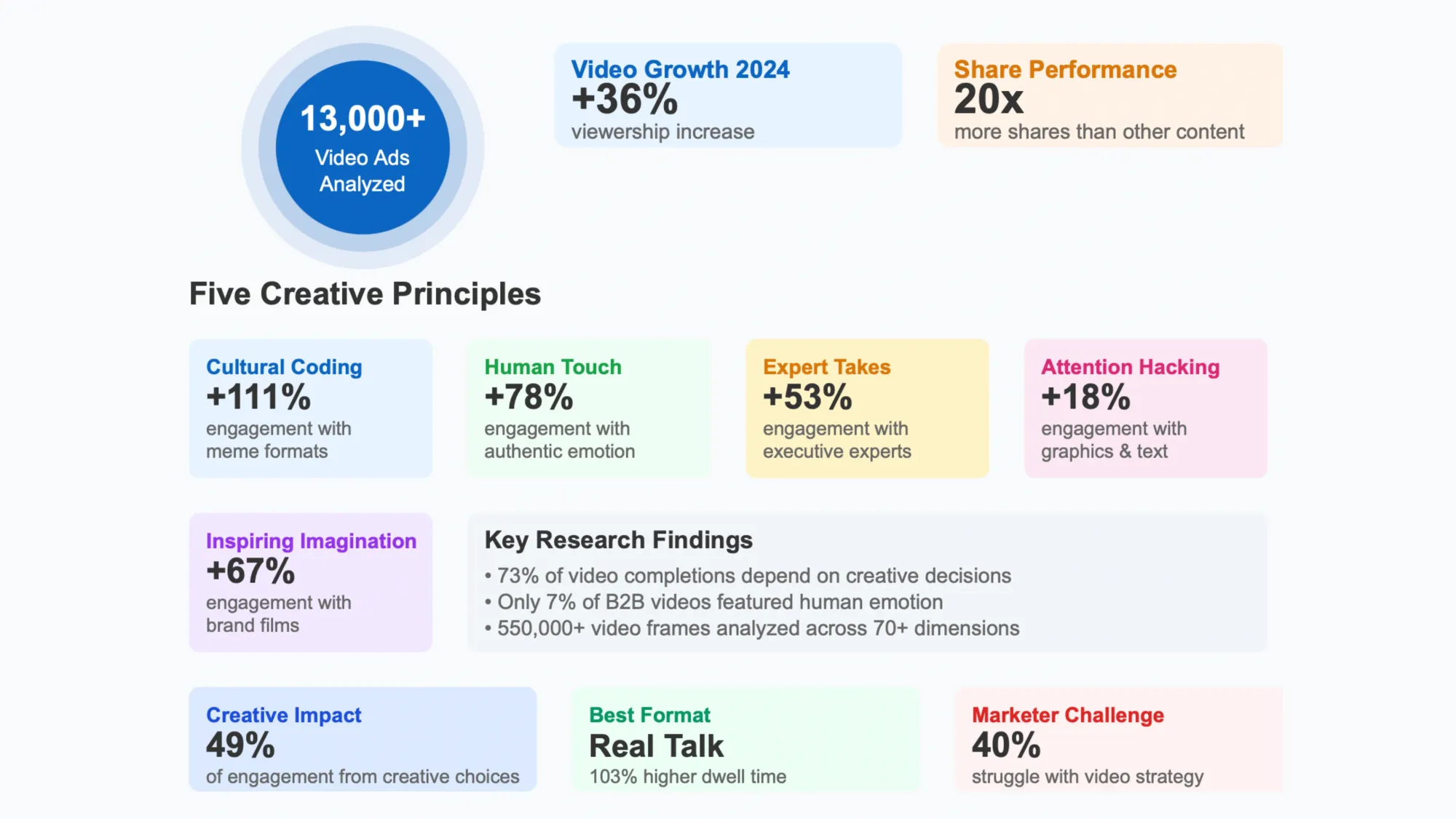LinkedIn Creative Labs reveals what makes B2B video content successful
LinkedIn's most comprehensive video marketing study analyzed 13,000 advertisements to determine the creative elements that drive higher engagement rates.

LinkedIn Creative Labs published comprehensive research on July 15, 2025, examining over 13,000 B2B video advertisements to identify the creative elements that drive performance. The study, titled "The Art & Science of Video Storytelling," represents the most extensive analysis of video effectiveness on the professional networking platform to date.
According to the research, video posts generate 20 times more shares than any other content format on LinkedIn. Video viewership on the platform increased by 36% in 2024, reaching 154 billion views. This data positions video as what LinkedIn calls "B2B's new lingua franca."
The analysis utilized Large Language Models and Machine Learning to examine over 550,000 video frames across more than 70 different dimensions. The research team found that 73% of video completions and 49% of video engagement rates depend on creative decisions rather than budget or production values.
Subscribe the PPC Land newsletter ✉️ for similar stories like this one. Receive the news every day in your inbox. Free of ads. 10 USD per year.
Summary
Who: LinkedIn Creative Labs research team led by Creative Thinker Wensy A., analyzing B2B marketing video content
What: Comprehensive study of 13,000 B2B video advertisements identifying five creative principles that drive higher engagement: Cultural Coding, Human Touch, Expert Takes, Attention Hacking, and Inspiring Imagination
When: Research published July 15, 2025, analyzing video performance data and creative elements using Large Language Models and Machine Learning
Where: Analysis conducted on LinkedIn platform video advertisements, examining over 550,000 video frames across more than 70 different dimensions
Why: To address the 40% of marketers who struggle with video strategy despite video posts generating 20 times more shares than other content, providing data-driven guidance for B2B video marketing effectiveness
Subscribe the PPC Land newsletter ✉️ for similar stories like this one. Receive the news every day in your inbox. Free of ads. 10 USD per year.
Five creative principles drive performance
The study identified five foundational principles that consistently produce higher engagement rates. Cultural Coding, which involves incorporating workplace culture, memes, and timely events, increased engagement by up to 111% when videos used meme formats. Videos referencing pop culture achieved a 41% uptick in engagement.
Human Touch emerged as another critical factor. Brand awareness videos displaying authentic emotion generated 78% higher engagement rates compared to staged content. Videos featuring real people showed a 14% uplift in engagement, while authentic content drove 41% greater engagement than staged alternatives.
Expert Takes proved particularly effective on LinkedIn's professional platform. When subject matter experts appeared in videos, engagement increased by 40%. Executive experts performed even better, driving a 53% lift in engagement rates. Videos filmed at conference stages rather than artificial environments saw 70% higher engagement.
Attention Hacking addresses the mobile-first feed environment where attention spans continue shrinking. Bold color palettes increased engagement by 15%, while graphics emphasizing key points drove an 18% lift. Videos with bulleted captions achieved 30% longer dwell times, and those with clear step-by-step structures saw 13% increases in dwell time.
Inspiring Imagination elevates content beyond product features through cinematic storytelling. Brand films between 31 and 60 seconds delivered a 61% uplift in engagement compared to six-second formats. Content featuring inspirational messages helped audiences imagine better futures, driving 36% more engagement.
Format specifications matter for targeting
The research distinguished between two standout video formats that work at different funnel stages. Blockbuster brand films, characterized by landscape orientation and longer duration, build brand awareness through cinematic narratives. These delivered 129% higher engagement compared to generic advertisements.
Real talk videos typically use vertical formats and mobile-native design, featuring real people speaking transparently. This approach performed well in mid-to-lower funnel stages, delivering 103% higher dwell time than generic ads for building trust at decision-making moments.
Face-to-camera videos delivered 34% higher engagement rates, while vertical video formats achieved 34% longer dwell times compared to traditional square-format content. Horizontal formats, which evoke cinematic experiences, achieved 59% higher dwell time than 1:1 aspect ratios.

Technical specifications and production insights
The study revealed specific technical elements that impact performance. Dynamic camera shots increased engagement effectiveness by 13%. Videos using soft, tonal color palettes held attention 20% more effectively than commercial-style grading.
Only 7% of the analyzed B2B video advertisements featured human emotion, representing what researchers identified as a missed opportunity. Videos focused on human experience delivered 18% greater engagement than those dealing with abstract concepts and 10% higher engagement than product-led messaging.
At the awareness stage, content perceived as credible delivered 17% longer dwell times than content with low credibility. During consideration phases, experts sharing contrarian viewpoints drove 22% more engagement than those taking safer approaches.
Marketing community implications
The research findings have significant implications for B2B marketing strategies. According to the study, 40% of marketers struggle to create effective video strategies despite 55% reporting that short-form social videos produce their highest return on investment.
Video marketing success in B2B has been demonstrated through measurable ROI improvements, with LinkedIn data showing short-form social videos generating 55% ROI rates. The platform's emphasis on authentic content aligns with broader industry trends toward less polished, more genuine marketing approaches.
The timing of this research coincides with LinkedIn's broader video ecosystem development. The platform recently launched BrandLink, which integrates pre-roll ads with contextual content in feeds, and introduced Connected TV advertising capabilities for reaching decision-makers on larger screens.
For B2B marketers operating on LinkedIn, these findings suggest a strategic shift toward authentic, culturally relevant content over highly produced corporate videos. The data indicates that understanding platform-specific behaviors and audience expectations drives better results than generic video marketing approaches.
Implementation recommendations
The research emphasizes several practical applications for marketing teams. Videos should be designed for mobile-first, sound-optional viewing environments, with 80% of LinkedIn videos watched without audio. Clear captions and visual elements become essential for maintaining engagement.
Content creators should focus on the first 4-6 seconds of videos, avoiding branding in favor of insights, statistics, or engaging questions. The optimal length for top-of-funnel content ranges from one to two minutes, while live streams and webinars perform best at 30-45 minutes.
Marketing measurement approaches should evolve beyond traditional metrics like Marketing Qualified Leads to include audience growth, content views, and profile visits. This broader perspective provides better insight into video strategy effectiveness across the complete customer journey.
The research suggests that successful B2B video marketing requires balancing creative authenticity with strategic technical implementation. Organizations that combine human-centered storytelling with platform-specific optimization techniques achieve superior engagement and business outcomes.
Research methodology and scope
LinkedIn Creative Labs conducted this analysis using human-guided artificial intelligence to examine video advertisements at scale. The team analyzed content according to more than 70 different dimensions, creating the most comprehensive picture available of B2B video storytelling effectiveness.
The study examined videos across various industries and campaign objectives, providing insights applicable to different B2B marketing contexts. The research methodology combined quantitative performance data with qualitative creative assessment, enabling identification of specific elements that correlate with higher engagement rates.
This data-driven approach to creative effectiveness represents a significant advancement in understanding video marketing performance. By connecting creative choices with measurable business outcomes, the research provides actionable guidance for marketing teams seeking to improve their video content strategies.
Key Terms Explained
Large Language Models (LLMs) represent artificial intelligence systems trained on vast text datasets to understand and generate human-like language. In this research, LLMs analyzed video content descriptions and metadata to identify patterns that correlate with engagement performance, enabling scale analysis impossible through manual review.
Machine Learning (ML) encompasses algorithms that improve automatically through experience without explicit programming. The study used ML to process 550,000 video frames, identifying visual elements and creative patterns that drive higher engagement rates across different B2B audience segments.
Dwell time measures how long users spend viewing content before scrolling away or taking action. This metric indicates genuine interest and engagement quality, distinguishing between brief glimpses and meaningful content consumption that suggests audience connection with the material.
Attribution modeling tracks the customer journey across multiple touchpoints to determine which marketing activities contribute to conversions. LinkedIn's data-driven attribution moves beyond last-click models to provide comprehensive visibility into how video content influences B2B purchase decisions throughout extended sales cycles.
Creative effectiveness quantifies how well creative elements drive desired marketing outcomes. The research methodology connects specific visual, audio, and narrative components with measurable performance metrics, enabling marketers to optimize content based on proven creative principles rather than assumptions.
Engagement rate calculates the percentage of viewers who interact with content through likes, comments, shares, or clicks. This metric provides insight into content resonance and audience connection, helping marketers understand which creative approaches generate active participation versus passive consumption.
Conversion API (CAPI) enables direct data transmission between advertisers' servers and platform systems, bypassing browser limitations. This technical integration allows real-time sharing of qualified lead information, improving campaign optimization and attribution accuracy for B2B marketing campaigns.
Brand awareness objective represents advertising campaigns designed to increase recognition and familiarity rather than immediate conversions. These campaigns focus on reaching new audiences and building long-term brand equity through repeated exposure and positive associations with target demographics.
Connected TV (CTV) describes internet-enabled television viewing through streaming services, smart TVs, or connected devices. This advertising channel combines television's visual impact with digital targeting precision, enabling B2B marketers to reach decision-makers in premium viewing environments.
Programmatic advertising automates ad buying through software platforms that purchase digital advertising space in real-time auctions. This approach enables precise audience targeting and budget optimization, allowing B2B marketers to efficiently reach specific professional demographics across multiple digital channels.
Timeline
- July 15, 2025: LinkedIn Creative Labs publishes "Pixels and Promises: What 13,000 B2B Videos Revealed About What Really Works" research
- July 8, 2025: LinkedIn announces Member Post Analytics API launch with 11 third-party platform integrations
- July 2, 2025: LinkedIn launches frequency capping for brand awareness campaigns
- May 1, 2025: LinkedIn debuts BrandLink integrating pre-roll ads with contextual content
- January 27, 2025: Research shows video marketing in B2B generates highest ROI through short-form content
- January 11, 2025: LinkedIn adds advanced attribution and lead optimization features
- April 7, 2024: LinkedIn debuts CTV Ads for B2B marketers targeting US and Canada

